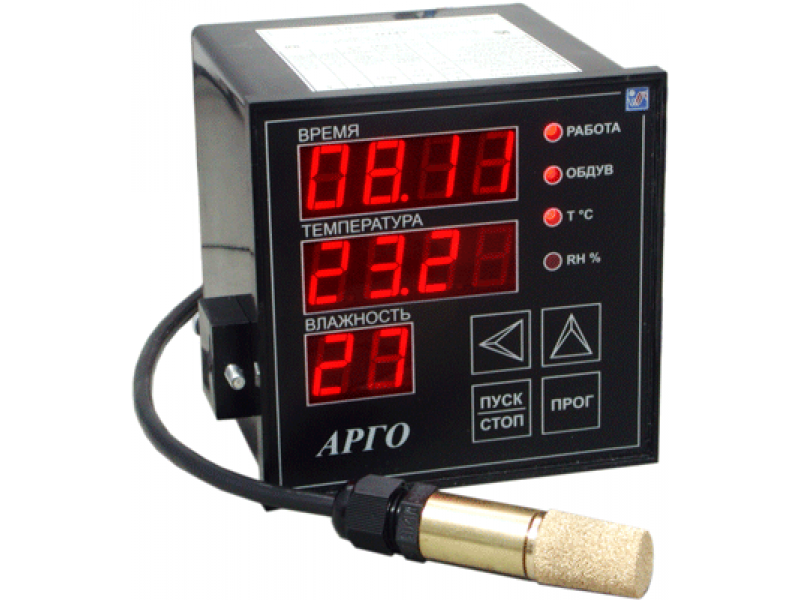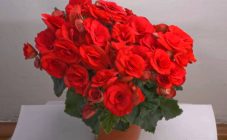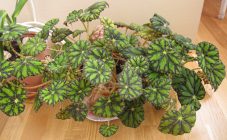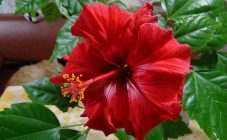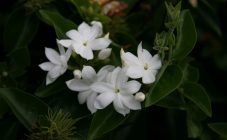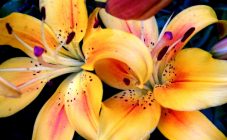Content:
Tuberous begonia appeared as a result of many years of breeding experiments. This is an artificially bred hybrid species, in the creation of which more than 9 plant species from different parts of the world were involved. The idea arose back in the nineteenth century, and today there are about 200 species of this wonderful colorful perennial plant.
Feature and Description
Tuberous begonia differs from ordinary begonia in that it can be grown as a garden perennial flower. Moreover, it can be different:
- herbaceous;
- bush;
- ampelous.
This begonia is ideal for decorating outdoor terraces and balcony niches.
Tuberous begonia has several characteristics that distinguish it from its congeners. One of them is a root in the form of a tuber about 5-6 cm. The height of the stem, which grows quite dense and thick, can reach 1 meter.
Another difference is the exuberant and long-term flowering of bright flowers of various colors, the appearance of which is also very different both in the type of petals (double, non-double, with denticles or fringe at the edges, in a fold), and in the very shape (similar to roses and peonies, large daffodils, carnation).
The size of flowers is different in diameter, and they can also grow in an inflorescence or be single - it all depends on the variety.
Unusually, tuberous begonia has heterosexual flowers: males, as a rule, are larger and brighter, attracting attention, females are not so striking, because their appearance is much more modest and usually it is about five smooth petals.
Care is simple: the plant does not like to drop in temperature. Ideal for growing and flowering 16-28 degrees Celsius. To preserve from frost in mid-autumn, the tubers need to be dug up and stored in a dark place for wintering until spring. In conditions of indoor cultivation, it will delight with flowers until December, and then it goes into a state of rest.
Variety of varieties
Decoratively bright and varied tuberous begonia is represented by many varieties with different types, shapes and color of flowers.
Non stop variety
Royal variety with flowers more than 10 cm in diameter.Each individual flower is a terry collection of petals in a large bright bud, of which there are quite a few on a small plant only 20-30 cm.
The flowers of this variety are of an unusual appearance - they are two-colored. The variety itself is represented by 12 different hybrids of white, yellow, pink, apricot and red.
Non stop begonia grows in the form of a bush with well-developed horizontal branches, the length of which is easily adjustable. Thanks to this, it is recommended for decorating various landscape compositions.
Odorant grade
Begonia Odorata is in the form of a herbaceous bush with spreading branches about 20 cm high.It has large double inflorescences with white-pink buds up to 9 cm in diameter.
Flowering time June-October. Well suited for interior decoration, as well as a garden or balcony.
Variety of Grandiflora
The plant is small, covered with a large number of multicolored pink-shaped large flowers (diameter reaches 20 cm).
The petals can be smooth or double, which creates additional volume for the buds.
Breeding begonia
Tuberous begonia, the reproduction of which does not require much trouble, is bred in two ways: cuttings and leaves.
- Cuttings.
You can cut an annual, strengthened plant. Most often, this is the rooting of the stem or, less often, leaves cut from an adult flower.
It is necessary to choose a section for a cut 9-12 cm long (preferably the upper or middle part of the stem), which should have several active buds.
Leaves are removed, with the exception of 2-3 pieces. Rooting takes place in water at room temperature, where the cutting is placed. After a while, roots appear on the cut of the stem. From this point on, the plant is suitable for subsequent cultivation.
- Leaf breeding.
In this case, both the whole sheet and part of it can be used. How to propagate with a whole leaf: it is stuck with a cut into damp, loose earth and grows over time. In another case, transverse cuts are made on the sheet plate, controlling a snug fit, the sheet is laid face up on the ground.
When using parts of the leaves, some rules must be observed: it is better to plant each fragment in a separate container, the cut must be in close contact with the soil. You can also resort to laying the parts, similar to the method described above with whole sheet plates.
For moistening it is sprayed with water, the earth must not be allowed to dry out. When new leaves and shoots appear, a new stage begins - adaptation. This is a long-term process of accustoming the plant to fresh air by increasing the period of airing the greenhouse.
The sprouts will get stronger and gain strength only after 2-3 months, after which they can be planted in a garden or on a plot.
What should be the soil
This is not to say that begonias tubers are very demanding on soil properties. The main thing is that the soil is fertile, neutral acid reaction and loose structure. For self-cooking, you need a ratio of 2/1/1/1 from:
- turf;
- vegetable humus;
- peat;
- medium-sized sand.
In order for begonia to grow and reproduce normally, a similar composition can be purchased at the store. If one is not available, a universal soil mixture for flowering plants is also suitable.
To grow an annual plant indoors, you should take care of a good drainage layer in the pot.
Rules for the care of tuberous begonia
With all its external sophistication and beauty, this type of home begonia is absolutely unpretentious both in indoor and in garden conditions.
Lighting requirements
Like any other plant, begonia does not tolerate direct sunlight, especially in the period from 12 to 17 hours. If there are drops of water on the leaves of the plant, burns may appear under the influence of the rays. The most suitable would be the soft dim light of the morning or evening hours.
In indoor breeding conditions, additional artificial lighting with lamps may be required from the end of autumn to throughout the winter. At this time, the plant requires an extension of daylight hours up to 12 hours.
Temperature regime
The most comfortable temperature for tuberous begonias is + 18 + 20 ° С in summer and + 12 + 15 ° С in winter (with indoor breeding). Moreover, both a decrease and an increase in temperature will be detrimental to the plant. At + 5 ° С, not only flowers, but also leaves will crumble, and in the heat the soil will dry out and, again, buds and greens will be lost.
Humidity
Begonia does not tolerate dry air. Humidity should be around 50%. In the heat, additional spraying is necessary to simply moisten the soil.
In living quarters, you should not place a flower next to radiators, stoves and other household appliances, since there is not enough humid air next to them.
How to water
In the case of this type of begonia, a not very long drought will be tolerated more easily than waterlogging or root clogging. High humidity will lead to disease and death of the plant.
Watching the condition of the soil in the container, it is enough to water with a visual drying of the upper layer with a small amount of liquid.
Feeding begonias
Fertilization should be carried out throughout the active period from spring to mid-autumn. The frequency is approximately two weeks.
During dormancy, the plant does not require fertilization, even if it is a constantly flowering species.
About diseases and pests
Subject to all of the above simple rules for breeding and growing, begonia will be beautiful and healthy. Any problems that arise are the result of a violation of the content rules, the causes of which are easy to detect and eliminate:
- during the drying out of the soil, the leaves will dry;
- with waterlogging, rotting of the stems will occur;
- bright sun rays will cause white burns;
- falling flowers and leaves - a consequence of hypothermia;
- with a lack of feeding, begonia becomes shallow both in terms of leaf plates and in relation to buds.
As with most garden plants, pests such as aphids, spider mites, scale insects and thrips are characteristic of tuberous begonias. All of them are expelled using insecticides.
When humidity or lighting problems occur, stains and plaque may appear on the leaves due to diseases such as powdery mildew or gray mold. In this case, it is necessary to resort to spraying with benomyl fungicides.
Unpretentiousness and excellent decorative properties of begonias are good indicators for starting cultivation in any garden, plot or home.
In order to grow this queen, you do not need to be a landscape designer or have extensive gardening experience, you just need to love and cherish a flower. Care and all energy costs will return with unmatched beauty and abundance of flowering.






